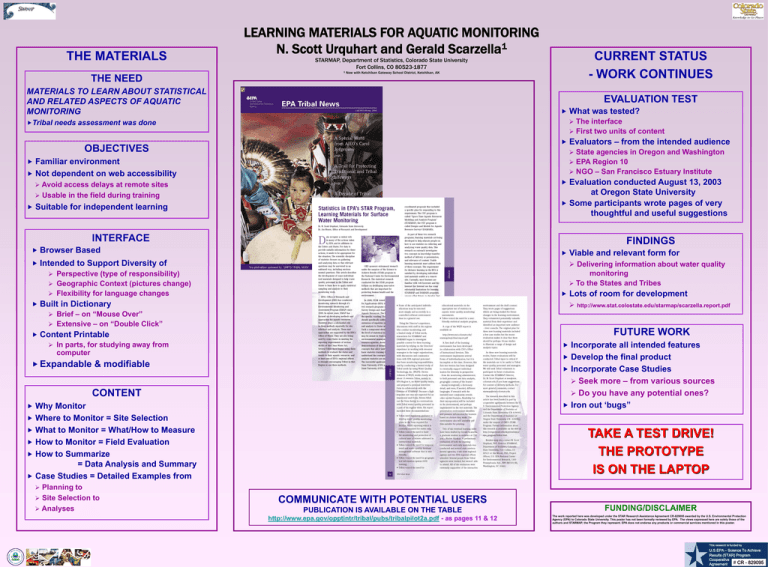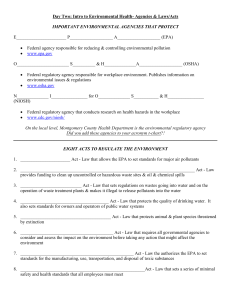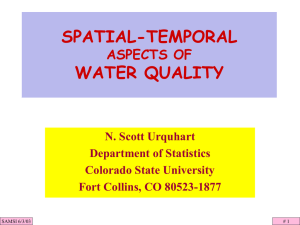LEARNING MATERIALS FOR AQUATIC MONITORING N. Scott Urquhart and Gerald Scarzella
advertisement

THE MATERIALS LEARNING MATERIALS FOR AQUATIC MONITORING 1 N. Scott Urquhart and Gerald Scarzella 1 THE NEED CURRENT STATUS - WORK CONTINUES STARMAP, Department of Statistics, Colorado State University Fort Collins, CO 80523-1877 Now with Ketchikan Gateway School District, Ketchikan, AK MATERIALS TO LEARN ABOUT STATISTICAL AND RELATED ASPECTS OF AQUATIC MONITORING EVALUATION TEST What was tested? The interface First two units of content Tribal needs assessment was done Evaluators – from the intended audience State agencies in Oregon and Washington EPA Region 10 NGO – San Francisco Estuary Institute OBJECTIVES Familiar environment Not dependent on web accessibility Evaluation conducted August 13, 2003 Avoid access delays at remote sites at Oregon State University Some participants wrote pages of very thoughtful and useful suggestions Usable in the field during training Suitable for independent learning INTERFACE FINDINGS Browser Based Viable and relevant form for Intended to Support Diversity of Perspective (type of responsibility) Geographic Context (pictures change) Flexibility for language changes Delivering information about water quality monitoring To the States and Tribes Lots of room for development Built in Dictionary Brief – on “Mouse Over” Extensive – on “Double Click” http://www.stat.colostate.edu/starmap/scarzella.report.pdf FUTURE WORK Content Printable In parts, for studying away from computer Incorporate all intended features Develop the final product Expandable & modifiable Incorporate Case Studies Seek more – from various sources CONTENT Do you have any potential ones? Iron out ‘bugs” Why Monitor Where to Monitor = Site Selection What to Monitor = What/How to Measure TAKE A TEST DRIVE! THE PROTOTYPE IS ON THE LAPTOP How to Monitor = Field Evaluation How to Summarize = Data Analysis and Summary Case Studies = Detailed Examples from Planning to Site Selection to Analyses COMMUNICATE WITH POTENTIAL USERS PUBLICATION IS AVAILABLE ON THE TABLE http://www.epa.gov/opptintr/tribal/pubs/tribalpilot2a.pdf - as pages 11 & 12 FUNDING/DISCLAIMER The work reported here was developed under the STAR Research Assistance Agreement CR-829095 awarded by the U.S. Environmental Protection Agency (EPA) to Colorado State University. This poster has not been formally reviewed by EPA. The views expressed here are solely those of the authors and STARMAP, the Program they represent. EPA does not endorse any products or commercial services mentioned in this poster. This research is funded by U.S.EPA – Science To Achieve Results (STAR) Program Cooperative # CR - 829095 Agreement






